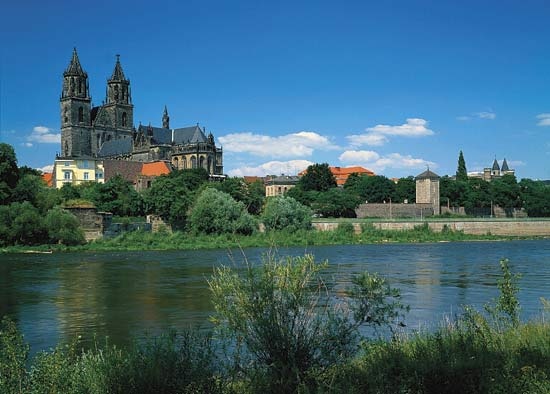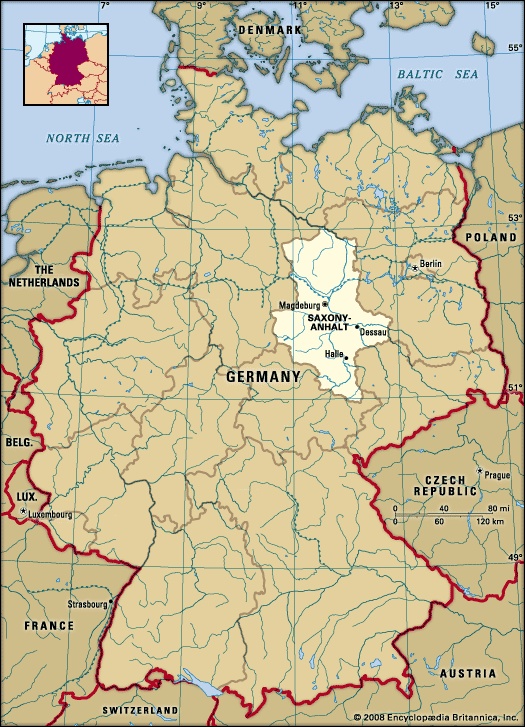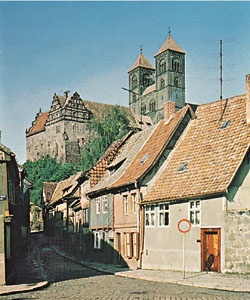Saxony-Anhalt
state, Germany
Introduction
German Sachsen-Anhalt

 Land (state), east-central Germany. Saxony-Anhalt borders the German states of Brandenburg to the east, Saxony to the south, Thuringia to the southwest, and Lower Saxony to the northwest. The state capital is Magdeburg. Area 7,895 square miles (20,447 square km). Pop. (2006 est.) 2,441,787.
Land (state), east-central Germany. Saxony-Anhalt borders the German states of Brandenburg to the east, Saxony to the south, Thuringia to the southwest, and Lower Saxony to the northwest. The state capital is Magdeburg. Area 7,895 square miles (20,447 square km). Pop. (2006 est.) 2,441,787.Geography
Almost all of Saxony-Anhalt lies within the North European Plain, and its landscapes exhibit impacts from successive eras of glaciation. The Elbe River flows through the eastern and northern portions of the state, while the south is drained by two of the Elbe's tributaries, the Saale (Saale River) and Mulde (Mulde River) rivers. The sandy plains of the valley of the Elbe are interspersed with farmlands, pastures, pine forests, and bog lands. The southwest portion of the state includes parts of the Harz mountains, adjacent foothills, and the fertile Harz Foreland, which lies between the hills and the Halle- Leipzig conurbation. The central portion of Saxony-Anhalt is occupied by the Fläming Hills and the fertile Börde region, which extends from the Harz foothills in the southwest to the Elbe at Magdeburg. Apart from the valley of the northward-flowing Elbe, the northernmost segment of the state mostly consists of the Altmark heath. About two-thirds of the landscape is in farmland; roughly another one-fifth is covered by forests. Most of Saxony-Anhalt has a temperate climate influenced by the Atlantic Ocean, though the climate of the Harz is harsher.
Saxony-Anhalt's population is composed almost entirely of ethnic Germans. There is no significant indigenous ethnic minority, and the foreign population is very small. From the mid-20th century, the state's population declined dramatically, losing about one-fifth of its inhabitants between 1960 and the beginning of the 21st century. Population densities vary greatly, from the thinly populated north to the quite densely populated Börde region and industrialized, urbanized south.
Though agriculture in Saxony-Anhalt dominates much of the landscape, it plays a quite modest role in total output and employment. The fertile lowlands of the Börde region and of the Saale (Saale River) and Mulde (Mulde River) river valleys support the cultivation of wheat, rye, barley, rape, sugar beets, and fodder crops. This productive agriculture has given rise to important local food-processing industries, especially sugar-refining and flour-milling. Cattle are also raised, and cheese production is important. The heathlands produce some rye, potatoes, and cattle.
The major industrial resource in Saxony-Anhalt is lignite, mined in several locations in the southeastern part of the state in a coalfield that straddles the border of Saxony and Saxony-Anhalt, with an additional small area in adjacent Thuringia, within what is called the Central German Coalfield. Between unification in 1990 and the beginning of the 21st century, production dropped by more than three-fourths and employment by more than nine-tenths. While the mining of metals has ceased since German unification, some production of potash continues in Zielitz.
 Like other eastern German states, Saxony-Anhalt suffered severe economic recisions in production and employment in virtually all sectors following unification. In the early 2000s the state was considered to be among Germany's poorest, with high unemployment, especially in the former mining and chemical works regions in the south. Decreased economic activity, however, especially reductions in chemical and lignite production, has led to dramatic improvement in air quality in the postunification era. Although Saxony-Anhalt's economy, including manufacturing, has shrunk, the state's two main industrialized regions continue to be of some importance. Magdeburg, almost completely flattened during combat in World War II, was rebuilt in the postwar era. It has food-processing and metalworking industries. In southern Saxony-Anhalt a line of cities and towns from Dessau south through Zeitz, including Wolfen, Bitterfeld, Halle, Merseburg, and Leuna, have varied chemical, machinery, and metallurgical plants, as well as food processing. Aspirin manufacturer Bayer has a large complex in Bitterfeld. Saxony-Anhalt also has a modest tourist industry that primarily serves German travelers.
Like other eastern German states, Saxony-Anhalt suffered severe economic recisions in production and employment in virtually all sectors following unification. In the early 2000s the state was considered to be among Germany's poorest, with high unemployment, especially in the former mining and chemical works regions in the south. Decreased economic activity, however, especially reductions in chemical and lignite production, has led to dramatic improvement in air quality in the postunification era. Although Saxony-Anhalt's economy, including manufacturing, has shrunk, the state's two main industrialized regions continue to be of some importance. Magdeburg, almost completely flattened during combat in World War II, was rebuilt in the postwar era. It has food-processing and metalworking industries. In southern Saxony-Anhalt a line of cities and towns from Dessau south through Zeitz, including Wolfen, Bitterfeld, Halle, Merseburg, and Leuna, have varied chemical, machinery, and metallurgical plants, as well as food processing. Aspirin manufacturer Bayer has a large complex in Bitterfeld. Saxony-Anhalt also has a modest tourist industry that primarily serves German travelers.Magdeburg is Saxony-Anhalt's major service and university centre in the north and an important inland port and trucking centre. Halle is the dominant service and university centre in the south, as well as the site of major new suburban retail concentrations. Dessau serves as an important service centre for the region north of Halle.
The Börde region has excellent rail, road, and navigable waterway networks that carry passengers and cargo not only within the region but also east-west across Germany and Europe. The city of Magdeburg, along the Elbe, is especially well connected to Germany's east-west oriented transport systems by the Mittelland Canal, major rail lines, and highways.
 Saxony-Anhalt is governed by a parliament and a minister-president, who is generally a leading member of the parliament's strongest party. The state offers a variety of cultural activities. The most appealing natural area in the state is the Harz region, composed of both low mountains and high hills. The area around Brocken, the highest point of the Harz mountains (3,747 feet 【1,142 metres】), is part of Harz National Park, which spans the border with Lower Saxony. A number of urban attractions also draw visitors, notably the beautifully restored medieval architecture in Quedlinburg and Wernigerode on the northern flanks of the Harz. Quedlinburg, with its timber-framed buildings and Romanesque church, is a UNESCO World Heritage site (designated in 1994).
Saxony-Anhalt is governed by a parliament and a minister-president, who is generally a leading member of the parliament's strongest party. The state offers a variety of cultural activities. The most appealing natural area in the state is the Harz region, composed of both low mountains and high hills. The area around Brocken, the highest point of the Harz mountains (3,747 feet 【1,142 metres】), is part of Harz National Park, which spans the border with Lower Saxony. A number of urban attractions also draw visitors, notably the beautifully restored medieval architecture in Quedlinburg and Wernigerode on the northern flanks of the Harz. Quedlinburg, with its timber-framed buildings and Romanesque church, is a UNESCO World Heritage site (designated in 1994). In the south the Bauhaus Building and Masters' Houses in Dessau have been designated a UNESCO World Heritage site (1996) in recognition of the Bauhaus school's profound influence on 20th-century architecture and design. A second World Heritage site in Dessau is the Garden Kingdom of Dessau-Wörlitz, an exceptional example of 18th-century landscape design. Two towns in Saxony-Anhalt are so closely associated with Martin Luther (Luther, Martin), the priest and scholar who set in motion the Protestant Reformation, that they are officially referred to as Lutherstadt Eisleben and Lutherstadt Wittenberg. The Luther Memorials in Eisleben and Wittenberg constitute yet another World Heritage site (1996), consisting of houses and churches associated with the lives of Luther and his close associate the writer and educator Philipp Melanchthon (Melanchthon, Philipp). The majestic cathedral in Naumburg and sights and cultural events in Halle, most notably the annual Handel music festival, also draw visitors.
In the south the Bauhaus Building and Masters' Houses in Dessau have been designated a UNESCO World Heritage site (1996) in recognition of the Bauhaus school's profound influence on 20th-century architecture and design. A second World Heritage site in Dessau is the Garden Kingdom of Dessau-Wörlitz, an exceptional example of 18th-century landscape design. Two towns in Saxony-Anhalt are so closely associated with Martin Luther (Luther, Martin), the priest and scholar who set in motion the Protestant Reformation, that they are officially referred to as Lutherstadt Eisleben and Lutherstadt Wittenberg. The Luther Memorials in Eisleben and Wittenberg constitute yet another World Heritage site (1996), consisting of houses and churches associated with the lives of Luther and his close associate the writer and educator Philipp Melanchthon (Melanchthon, Philipp). The majestic cathedral in Naumburg and sights and cultural events in Halle, most notably the annual Handel music festival, also draw visitors.History
Saxony-Anhalt had its origins in the principality of Anhalt, which was a duchy from 1863 to 1918 and a state of Germany from 1918 until 1945, when it became part of Saxony-Anhalt. The latter was a newly created state of East Germany (the German Democratic Republic) from 1949 until 1952, at which time it was broken up into the Bezirke (districts) of Magdeburg and Halle. Upon the reunification of East Germany with West Germany in 1990, the post-World War II state of Saxony-Anhalt was reconstituted to include former Magdeburg and most Halle districts.